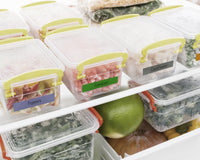“How removable are your removable labels?” While this might seem like a silly question at first glance, we get this inquiry all the time, and it’s actually a great question! So here’s a quick guide to help you determine what type of labels are best for you and your application.
Let’s say you need a removable label – obviously it needs to stick to the surface for a time, then be able to be removed. Should you always just get a removable label?
Not… always. Because sometimes you might need to get a permanent label to be able to remove it.
Confused? We can explain.
Surface Energy – Complicated Concept, Easy to Explain
It all comes down to the “surface energy” of the material you’re going to be putting the label on. Everything has a surface energy. Without getting into some really cool but really complicated physics, it all has to do with this idea: attraction between objects.
To best explain this, let’s look at two cooking pans: non-stick and stainless steel. The non-stick pan is slicker than the steel pan – and it’s not because of voodoo or magic. It’s actually because there’s Teflon on it – which is a material that has lower surface energy than steel. So things that are in the pan are more likely to stick to themselves than the pan.
Another example is looking at a car windshield. A normal windshield is going to have water streak and kind of pool up, compared to a windshield that has just been waxed. When you apply the wax or something like Rain-X, you are lowering the surface energy of the windshield. The water doesn’t want to spread out and get “sticky” on the windshield – it wants to stick to itself. So it beads up and rolls off.
What does this have to do with labels?
A lot. So let’s go back to our original thought: you need a removable label. If you call us or chat us, the first question we always ask is, “what is the surface?”. If it’s a low surface energy material, we may send you permanent labels, since they’ll actually become removable on that surface. Can you use removable labels on that material? Sorta, but they’ll probably fall right off. You’ve probably noticed that those yellow sticky notes work perfect on paper or a wood desk – but they kind just flutter off when you put them on a whiteboard? That’s how our removable labels will behave too.
Side note: Whiteboards – that’s how they work. You have two very low surface energy materials: the ink in the markers, and the surface of the whiteboard.
How can I tell what the surface energy of my material is?
Some common materials that have very low surface energy and would probably need to be tested out first are: Teflon, Polypropylene (PP), Polyethylene (PE), Acrylic, and PVC.
I have no idea what the material is though…
Sure, here’s an easy test instead – put some water droplets on it. If they bead up into little droplets, and don’t spread out, you have a low surface energy (labels won’t stick to it as easily). If they spread out into flat little puddles, you have high surface energy (labels will totally stick to it).
Or just request a sample before you place an order! We’d be thrilled to send you some removable and some permanent for you to test. Or you can just give us a call and ask us what we think would be best. In the 45-plus years we’ve been doing this, we’ve probably helped someone with an application just like yours.






